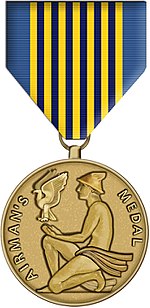Loading AI tools
Award From Wikipedia, the free encyclopedia
The Airman's Medal (AmnM) is a military award and decoration of the United States Air Force and United States Space Force for personnel who distinguish themselves by heroism involving voluntary risk of their life not involving actual combat with an armed enemy of the United States. The medal was established on 6 July 1960 by 10 U.S. Code 8750 and is awarded to those service members or those of a friendly nation while serving in any capacity with the U.S. Air Force or U.S. Space Force. The performance must have involved personal hazard or danger.
| Airman's Medal | |
|---|---|
 | |
| Type | Personal military decoration |
| Awarded for | a heroic act, usually at the voluntary risk of his or her life but not involving actual combat |
| Presented by | United States Department of the Air Force |
| Eligibility | Members of the Armed Forces of the United States or of a friendly nation |
| Status | Currently awarded |
| Established | 6 July 1960 Retroactive after 10 August 1956 |
| First awarded | 21 July 1960 |
| Precedence | |
| Next (higher) | Distinguished Flying Cross |
| Equivalent | Army: Soldier's Medal Naval Service: Navy and Marine Corps Medal Coast Guard: Coast Guard Medal |
| Next (lower) | Bronze Star Medal |
The Airman's Medal was authorized on 10 August 1956 to replace the U.S. Army's Soldier's Medal which had also been awarded to qualifying Air Force personnel since 26 September 1947. According to Air Force Instruction 36–2803, The Office of the Secretary of the Air Force, Personnel Council approves or disapproves recommendations for Airman's Medals requiring Secretary of the Air Force final approval and determines upon approval, entitlement to 10 percent increase in retirement pay for the Airman's Medal when awarded to enlisted members for extraordinary heroism.[1]
The Airman's Medal is equivalent to the Army's Soldier's Medal, the Navy and Marine Corps Medal, and the Coast Guard Medal. Additional awards of the Airman's Medal are denoted by oak leaf clusters.
The first recipient of the Airman's Medal was Captain John Burger, U.S. Air Force, who was awarded the medal at MacDill Air Force Base, Florida, on 21 July 1960, for heroism performed on 9 September 1959.
The medal was designed and sculpted by Thomas Hudson Jones of the Army Institute of Heraldry. On the obverse of the circular medal is the figure of the Greek god Hermes, son of Zeus, resting on one knee. He has just released from his open hands an American Bald Eagle, shown rising into flight. Within the raised rim of the medal, is the inscription "Airman's Medal" in raised letters. The reverse of the medal, has a raised outer edge and bears the inscription: “For Valor” above a space for the recipient's name which is within a stylized laurel wreath open at the top and tied at the bottom.
The Airman's Medal is unique in that its shape does not follow the octagonal shape of its counterparts, the Soldier's Medal, Navy and Marine Corps Medal and the Coast Guard Medal. It had been established practice heretofore to design military decorations with a distinctive shape, so that they would not be confused at a distance with service or campaign medals, which are always circular in shape. The reason for this is because the design was originally approved for use as the Air Force Distinguished Service Medal.[2]
Seamless Wikipedia browsing. On steroids.
Every time you click a link to Wikipedia, Wiktionary or Wikiquote in your browser's search results, it will show the modern Wikiwand interface.
Wikiwand extension is a five stars, simple, with minimum permission required to keep your browsing private, safe and transparent.